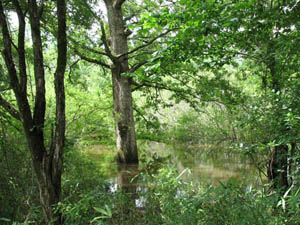|
| Home | | About Us | | Water Planning | |
Groundwater | |
Conservation | |
Environmental Flows | |
Drought Mgmt. | |
Resources | |
Search | | ||
|
Reservoirs or Conservation? The 2007 State Water Plan proposes building sixteen major dams and hundreds of miles of pipelines to move water to cities. These dams, many of them proposed for east Texas sites, would have harmful effects on the local economies and environment. Many of these dams could be avoided with responsible water conservation measures that would also save money. Dams are Destructive Damming a river destroys the wildlife habitat in the flooded area, but the impact of a reservoir doesn't end there. Dams also alter the natural flow of the river downstream and affect wildlife habitat below the reservoir. Dams trap waterborne sediments that are important for replenishing ecosystems downstream. Water in a reservoir generally has a more constant temperature than water in a free-flowing river and water released from a reservoir can change the temperature in a river, potentially impacting native fish and vegetation. Statewide, the amount of forested river and creek floodplain vegetation has declined from an estimated 16 million acres to 6 million acres. Some significant portion of this loss is due to the roughly 200 major reservoirs that have already been built. Visit our section on Environmental Flows to learn more about the impact that reservoirs and pipelines have on rivers and wildlife. Water Efficiency is the Future Efficiency programs generally cost far less than new reservoirs, pipelines and treatment plants. For every $1 the San Antonio Water System spends on conservation, they avoid $7 in new water supply costs. A 2009 planning effort by the Lower Colorado River Authority estimated that conservation programs would cost roughly $400 an acre-foot while the river authority's options for new pipelines and reservoirs would cost roughly $2000 an acre-foot. The 2007 State Water Plan underestimates the amount of water that could be saved through simple water efficiency measures. The 2007 report, "Save Water, Save Rivers, Save Money", shows that Texas cities could save 1.65 million acre-feet of water every year if they used water at similar rates as El Paso and San Antonio (140 gallons per capita per day). The 2007 State Water Plan includes just 613,000 of conservation savings and plans to construct 16 new reservoirs that would create 1.07 million acre-feet of water supply. Read the report to learn more about how saving water could save money and preserve some of Texas' wild places. Visit our section on Water Conservation to learn more about the potential for water conservation in Texas. Case Study: Marvin Nichols
|
|
||||||||||||||||||||||||||||||||


 Conservation
Conservation